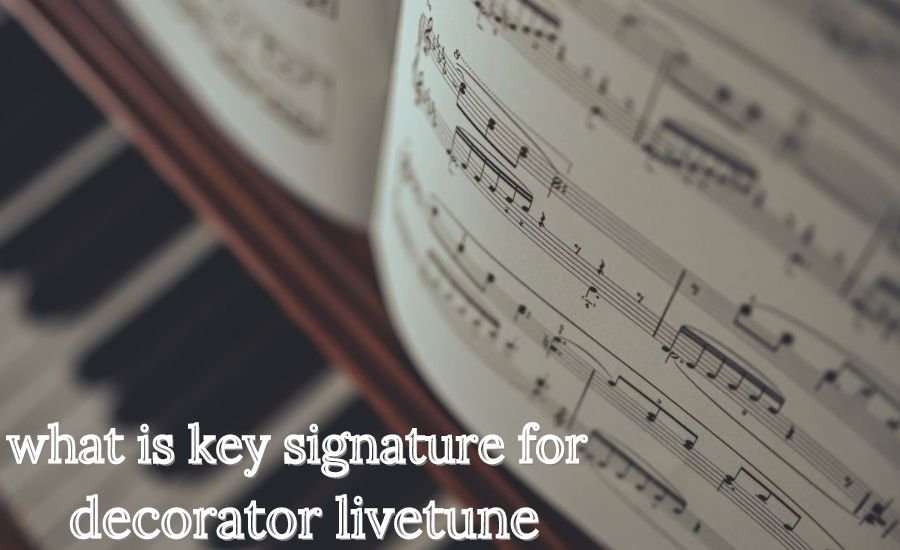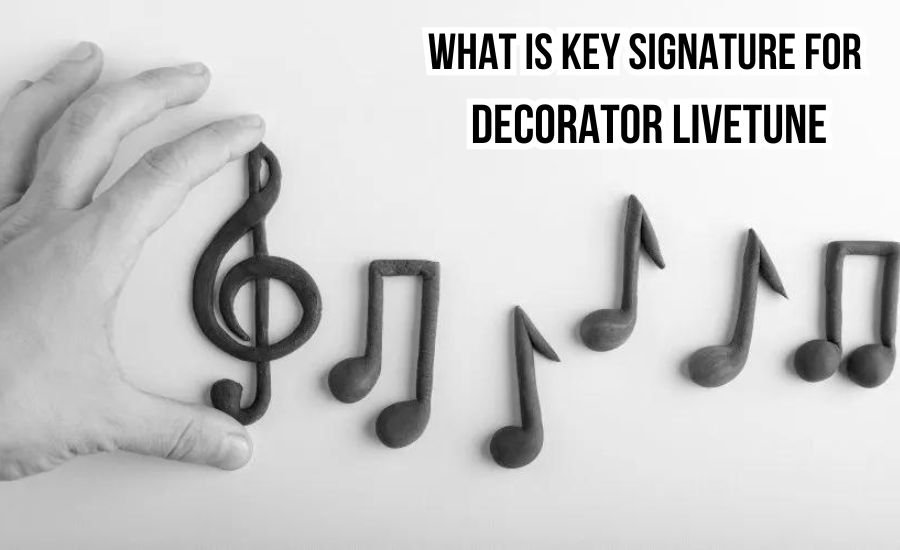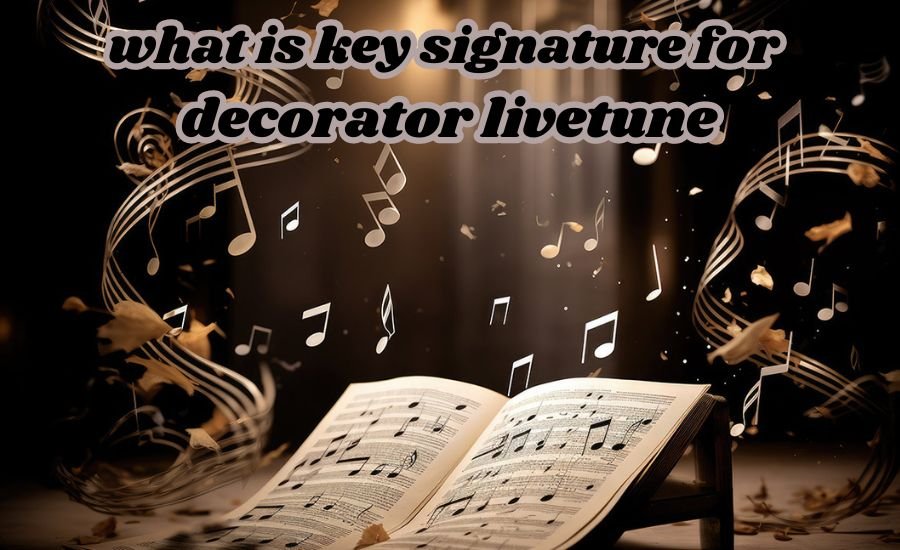If you’ve ever wondered what is key signature for Decorator Livetune, you’re in the right place! Key signatures are a fundamental part of music, helping to shape the sound and mood of a piece. In Decorator Livetune, this concept becomes even more exciting, as it allows you to experiment and explore different musical possibilities with ease.
In this blog post, we’ll break down what is key signature for Decorator Livetune in a way that’s easy to understand. We’ll look at why key signatures are important, how you can use them in your music, and some tips to get the most out of this tool. Whether you’re new to music or a seasoned pro, this guide will help you make the most of your creative journey.
What is Key Signature for Decorator Livetune? An Introduction
When we talk about what is key signature for Decorator Livetune, we are exploring a key part of music. Key signatures help musicians know which notes to play sharp or flat. This is important for making music sound just right. In Decorator Livetune, key signatures guide how you set up your music to make it sound great.
A key signature is like a map for musicians. It tells them what notes will sound different from the regular ones. For instance, if the key signature has sharps, certain notes will always be sharp in that piece. This helps keep the music consistent and helps musicians play the right notes.
Using key signatures in Decorator Livetune can make a big difference in how your music turns out. It gives you a framework to work with, so you can focus on being creative while staying on track. This makes it easier to create music that sounds harmonious and well-structured.
Why Understanding Key Signature for Decorator Livetune Matters
Knowing what is key signature for Decorator Livetune is very important for making good music. Key signatures help you set the tone and mood of your music. By understanding this, you can make sure your music fits the feeling you want to create. Whether you want something happy or sad, the key signature can help you achieve that.
For example, if you use a key signature with lots of sharps, your music might sound bright and energetic. On the other hand, a key signature with flats might give your music a softer, more mellow sound. This is why it’s important to choose the right key signature for the kind of music you want to make.
In Decorator Livetune, using the right key signature helps you stay organized and creative. It makes it easier to experiment with different sounds while still keeping everything in harmony. Understanding key signatures will also help you work better with other musicians, making sure everyone is on the same page.
How to Find the Right Key Signature for Decorator Livetune

Finding the right key signature in Decorator Livetune can make a big difference in how your music sounds. Understanding what is key signature for Decorator Livetune is the first step to choosing the perfect one for your project. Key signatures determine which notes are sharp or flat throughout a piece of music, setting the mood and tone.
Start by considering the mood you want your music to convey. Do you want it to feel happy and bright or more serious and reflective? For example, a major key signature often gives a cheerful vibe, while a minor key signature can add a more somber tone. By deciding on the mood, you can narrow down your key signature options.
Next, listen to the music you’ve created so far. Pay attention to which notes and chords you use most often. If you notice that certain notes are consistently sharp or flat, that might help you identify a key signature that fits. For instance, if you’re frequently using G sharp or D flat, you might want to choose a key signature that includes those notes.
Exploring Different Key Signatures with Decorator Livetune
When you explore different key signatures in Decorator Livetune, you open up new possibilities for your music. Each key signature gives a different feel to your music. For example, C major might sound bright and cheerful, while D minor could sound more serious or sad.
Experimenting with key signatures can lead to interesting and unique sounds. By trying out different options, you can discover new ways to express emotions in your music. This kind of exploration helps you find your own style and make your music stand out.
Remember that each key signature changes how your music feels. So, don’t be afraid to try out new ones and see what you like best. Decorator Livetune makes it easy to test out different key signatures, so you can find the perfect match for your music.
Common Key Signatures Used in Decorator Livetune
In Decorator Livetune, certain key signatures are used more often because they sound good in many situations. For example, C major is a popular choice because it sounds bright and clear. It’s great for happy and energetic music.
G major is another common key signature. It’s similar to C major but adds a bit more richness. This makes it suitable for a variety of musical styles, from lively to relaxed.
D minor is known for its sadder or more serious tone. It’s used when you want to create a more emotional or reflective piece. Each of these key signatures can bring out different feelings in your music, so choose one that fits the mood you want to create.
Tips for Choosing the Perfect Key Signature for Decorator Livetune
When deciding what is key signature for Decorator Livetune, it’s essential to pick the right one to ensure your music sounds just the way you want. Here are six tips to help you choose the perfect key signature for your compositions:
- Understand the Mood You Want to Create: Before selecting a key signature, think about the mood you want your music to convey. What is key signature for Decorator Livetune that can set the right tone? For a happy and lively piece, a major key signature might be best. On the other hand, if you’re aiming for a more somber or reflective mood, a minor key signature might be more suitable. Knowing the emotional direction of your piece helps guide your choice.
- Consider the Melody and Harmony: The melody and harmony of your music play a significant role in choosing the key signature. What is key signature for Decorator Livetune that complements your melodic lines? Ensure that the key signature you pick supports the notes and chords used in your melody and harmony. This alignment will help your music sound cohesive and well-structured.
- Experiment with Different Key Signatures: Don’t be afraid to experiment. Try out different key signatures and see how they affect your composition. What is key signature for Decorator Livetune that brings out the best in your music? By experimenting, you can find the key signature that enhances the overall sound and feel of your piece.
- Think About Instrumentation: Consider the instruments you’re using. Some key signatures work better with certain instruments. What is key signature for Decorator Livetune that suits your instrument choices? For example, certain key signatures might be easier to play on specific instruments or may sound better with the tonal qualities of your chosen instruments.
- Listen to Similar Music: Listen to music that is similar to what you are composing. What is key signature for Decorator Livetune used in pieces that have a similar style or genre? This can give you clues about which key signature might work well for your own music. Pay attention to how different key signatures affect the music you listen to.
- Use Tools and Resources: Utilize tools and resources available in Decorator Livetune to help you choose a key signature. Many music software programs offer features to test different key signatures easily. What is key signature for Decorator Livetune can be quickly explored using these tools to see how different options influence your composition.
By keeping these tips in mind, you can effectively choose the perfect key signature for your music in Decorator Livetune. This will help ensure that your compositions sound as intended and express the emotions you want to convey.
How Key Signature for Decorator Livetune Affects Your Music

The key signature for Decorator Livetune can have a big impact on your music. It sets the tone and mood, making your music sound just the way you want. By choosing the right key signature, you can make sure your music feels cohesive and well-organized.
Different key signatures can change how your music feels. For example, a major key signature might make your music sound happy and energetic, while a minor key signature could give it a more serious or sad tone. Understanding how these changes affect your music helps you create pieces that are both interesting and emotional.
In Decorator Livetune, the key signature helps you stay on track while exploring different sounds. It provides a framework for your music, making it easier to create compositions that are both creative and harmonious.
Step-by-Step Guide: Setting Key Signature in Decorator Livetune
Setting the key signature in Decorator Livetune can be done in a few simple steps. First, open your project and look for the section where you can choose the key signature. This is usually found in the settings or options menu.
Next, select the key signature that fits your music. You can experiment with different options to see which one sounds best. Don’t forget to listen carefully to how each key signature changes the mood of your piece.
Once you’ve chosen a key signature, apply it to your music and make any necessary adjustments. This step ensures that your music stays consistent and sounds the way you want it to. By following these steps, you can effectively set the key signature in Decorator Livetune.
Key Signature for Decorator Livetune: Tricks for Beginners
If you’re new to using key signature for Decorator Livetune, here are some tricks to help you get started. First, familiarize yourself with the basic key signatures. Knowing the most common ones can make it easier to choose the right one for your music.
Start by working with simple key signatures. As you become more comfortable, you can experiment with more complex ones. This gradual approach helps you build your skills and understanding.
Another useful trick is to listen to different types of music to hear how key signatures affect the sound. This can give you ideas for your own compositions and help you choose the best key signature for your projects.
Creative Uses of Key Signature for Decorator Livetune

Key signature for Decorator Livetune can be used creatively to enhance your music. By choosing different key signatures, you can explore various emotions and moods. This adds depth and interest to your compositions.
Try mixing and matching key signatures to create unique sounds. Sometimes, using an unexpected key signature can lead to interesting and original results. This kind of creativity can make your music stand out and capture the listener’s attention.
Don’t be afraid to experiment with key signatures in Decorator Livetune. The more you explore, the more you’ll discover how they can be used to create different musical effects and styles.
Troubleshooting Common Issues with Key Signature in Decorator Livetune
Sometimes, you might face issues with key signatures in Decorator Livetune. One common problem is selecting the wrong key signature, which can make your music sound off. To fix this, double-check your choice and make sure it matches the mood and style of your piece.
Another issue could be inconsistent notes due to incorrect key signatures. If you notice this, adjust the key signature and listen to how it changes the sound. This helps ensure that your music remains harmonious and well-balanced.
If you’re having trouble with key signatures, don’t hesitate to use online resources or ask for help. There are many tools and guides available that can assist you in resolving these issues and improving your music.
How to Change Key Signatures in Decorator Livetune Easily
Changing key signatures in Decorator Livetune is a straightforward process. First, open your project and locate the key signature settings. This is where you can select a new key signature for your music.
Choose the new key signature that fits your needs. As you make changes, listen carefully to how they affect your music. This helps ensure that the new key signature enhances your composition in the way you want.
After applying the new key signature, review your music and make any necessary adjustments. This step ensures that your piece remains consistent and sounds great with the new key signature.
The Impact of Key Signature on Your Music’s Mood in Decorator Livetune
When exploring what is key signature for Decorator Livetune, it’s important to understand how it affects your music’s mood. A key signature plays a crucial role in shaping the emotional feel of a composition. Each key signature can make your music sound happy, sad, tense, or relaxed.
For example, if you choose a key signature like C major, your music might feel bright and uplifting. This key signature is often used in cheerful and energetic pieces. On the other hand, if you select a key signature like A minor, your music might take on a more somber or reflective tone. This can be perfect for pieces that need to convey a sense of sadness or contemplation.
Understanding what is key signature for Decorator Livetune allows you to tailor the mood of your music to fit the message or feeling you want to express. By experimenting with different key signatures, you can discover how each one changes the overall atmosphere of your composition.
Don’t Skip: Red Room Comic Signed By Bryce
How to Combine Key Signatures in Decorator Livetune for Unique Sounds

Combining key signatures in Decorator Livetune can lead to interesting and unique sounds. Start by selecting two or more key signatures that you think might work well together. Experiment with how they blend to create new musical effects.
Try transitioning between different key signatures within your piece. This technique adds variety and keeps your music engaging. It also allows you to explore different emotions and moods throughout your composition.
Combining key signatures creatively can make your music stand out and sound more dynamic. Don’t be afraid to experiment and find new ways to use key signatures in your compositions.
Key Signature for Decorator Livetune: What You Need to Know
To understand key signature for Decorator Livetune, it’s important to know how it affects your music. Key signatures guide which notes will be sharp or flat, helping to shape the overall sound of your piece.
By choosing the right key signature, you can set the tone and mood for your music. It helps keep your composition organized and consistent, making it easier to create harmonious and engaging pieces.
Learning about key signatures and how to use them effectively in Decorator Livetune will improve your music-making skills. It allows you to experiment with different sounds and create compositions that truly reflect your creative vision.
Using Key Signature for Decorator Livetune to Improve Your Compositions
Key signature for Decorator Livetune can be a powerful tool to improve your compositions. By choosing the right key signature, you can enhance the mood and feeling of your music. This helps make your compositions more effective and expressive.
Experiment with different key signatures to see how they change your music. This can lead to new and exciting ideas, helping you develop your unique musical style. The more you explore, the better you’ll understand how to use key signatures to your advantage.
In Decorator Livetune, using key signatures creatively can elevate your music and make your compositions stand out. By applying what you’ve learned, you can create music that is both original and engaging.
Conclusion
In summary, understanding what is key signature for Decorator Livetune is essential for making great music. Key signatures guide you on which notes to play sharp or flat, helping your music sound just right. By picking the right key signature, you can make your music sound happy, sad, or anything in between. It sets the mood and makes your composition sound complete.
So next time you’re working with Decorator Livetune, remember how important the key signature is. It helps you stay organized and creative while making your music. Don’t be afraid to try different key signatures and see how they change your sound. With a bit of practice, you’ll find the perfect key signature for your music!
Read Next: www Thesoundstourcom
FAQs
Q: What is a key signature in Decorator Livetune?
A: A key signature in Decorator Livetune indicates which notes will be sharp or flat throughout your music piece. It helps guide musicians on how to play the notes correctly.
Q: How does the key signature affect my music in Decorator Livetune?
A: The key signature affects the overall sound and mood of your music. It determines the set of notes that will be sharp or flat, which influences the harmony and tone of your composition.
Q: Can I change the key signature while working in Decorator Livetune?
A: Yes, you can change the key signature at any time in Decorator Livetune. This allows you to experiment with different sounds and moods for your music.
Q: Why is it important to understand key signatures in Decorator Livetune?
A: Understanding key signatures helps you create music that is well-structured and harmonious. It ensures that your notes are consistent and align with the intended mood of your composition.
Q: How do I choose the right key signature in Decorator Livetune?
A: Choose a key signature based on the mood you want to create. For a bright and energetic feel, use a major key signature. For a more serious or sad tone, a minor key signature might be better.
Q: Can I use multiple key signatures in a single project in Decorator Livetune?
A: Yes, you can use multiple key signatures in a single project. This can add variety and dynamic changes to your music, making it more interesting.
Q: What should I do if my music sounds off after changing the key signature?
A: If your music sounds off, check if the new key signature is correctly applied. You may need to adjust your notes or chords to match the new key signature and restore harmony.
Q: Where can I find help with key signatures in Decorator Livetune?
A: For help with key signatures, refer to the Decorator Livetune user guide or online tutorials. You can also seek advice from music forums or professionals familiar with the software.



